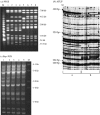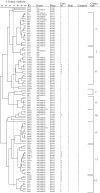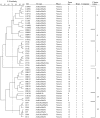Molecular epidemiology and diversity of Salmonella serovar Typhimurium in pigs using phenotypic and genotypic approaches
- PMID: 16409667
- PMCID: PMC2870365
- DOI: 10.1017/S0950268805004723
Molecular epidemiology and diversity of Salmonella serovar Typhimurium in pigs using phenotypic and genotypic approaches
Abstract
For epidemiological investigations of the most common and non-host-adapted Salmonella serotypes, such as Typhimurium, highly discriminatory approaches are essential. In the present study, we evaluated three genotyping methods; amplified fragment length polymorphism (AFLP), pulsed-field gel electrophoresis (PFGE) and repetitive palindromic extragenic-PCR (Rep-PCR) using 40 isolates. AFLP showed the highest discriminatory index (0.939), resolution and throughput. To determine clonality of Salmonella Typhimurium isolates and epidemiological relatedness in different commercial pig production units, we employed AFLP in combination with antimicrobial resistance pattern and phage typing. Salmonella serovar Typhimurium isolates (n=196) obtained from a longitudinal study of 18 pig farms over a 3-year period were studied. Using this approach, 16 distinct clonal types were identified. We found two common multidrug- resistant patterns including AmCmStSuTe and AmKmStSuTe. Two commonly multidrug- resistant phage types that are of known public health importance, DT104 and DT193, were also common. AFLP differentiated distinct clones within DT104, a phage type previously reported to be clonal. Fourteen of the clonal types were unique to one of the two production systems, showing diversity between independent commercial pig production systems located in the same geographical area. Clonal types obtained from nursery farms and corresponding finishing units were, however, similar.
Figures



Similar articles
-
Molecular characterization of multidrug-resistant Salmonella enterica subsp. enterica serovar Typhimurium isolates from swine.J Clin Microbiol. 2002 Aug;40(8):2813-22. doi: 10.1128/JCM.40.8.2813-2822.2002. J Clin Microbiol. 2002. PMID: 12149335 Free PMC article.
-
Characterization of Salmonella enterica serovar Typhimurium and monophasic Salmonella serovar 1,4,[5],12:i:- isolates in Thailand.J Clin Microbiol. 2005 Jun;43(6):2736-40. doi: 10.1128/JCM.43.6.2736-2740.2005. J Clin Microbiol. 2005. PMID: 15956391 Free PMC article.
-
Detection of multidrug-resistant Salmonella enterica serovar typhimurium phage types DT102, DT104, and U302 by multiplex PCR.J Clin Microbiol. 2006 Jul;44(7):2354-8. doi: 10.1128/JCM.00171-06. J Clin Microbiol. 2006. PMID: 16825349 Free PMC article.
-
Host specific differences alter the requirement for certain Salmonella genes during swine colonization.Vet Microbiol. 2011 Jun 2;150(3-4):215-9. doi: 10.1016/j.vetmic.2010.12.026. Epub 2011 Jan 11. Vet Microbiol. 2011. PMID: 21273009 Review.
-
Bacterial typing methods suitable for epidemiological analysis. Applications in investigations of salmonellosis among livestock.Vet Q. 1993 Dec;15(4):125-35. doi: 10.1080/01652176.1993.9694390. Vet Q. 1993. PMID: 8122347 Review.
Cited by
-
Salmonella enterica in commercial swine feed and subsequent isolation of phenotypically and genotypically related strains from fecal samples.Appl Environ Microbiol. 2010 Nov;76(21):7188-93. doi: 10.1128/AEM.01169-10. Epub 2010 Sep 17. Appl Environ Microbiol. 2010. PMID: 20851969 Free PMC article.
-
Accurate identification and discrimination of Salmonella enterica serovar Gallinarum biovars Gallinarum and Pullorum by a multiplex PCR based on the new genes of torT and I137_14430.Front Vet Sci. 2023 Jul 5;10:1220118. doi: 10.3389/fvets.2023.1220118. eCollection 2023. Front Vet Sci. 2023. PMID: 37476820 Free PMC article.
-
Phenotypic and Genotypic Eligible Methods for Salmonella Typhimurium Source Tracking.Front Microbiol. 2017 Dec 22;8:2587. doi: 10.3389/fmicb.2017.02587. eCollection 2017. Front Microbiol. 2017. PMID: 29312260 Free PMC article. Review.
-
Longitudinal study of Salmonella dispersion and the role of environmental contamination in commercial swine production systems.Appl Environ Microbiol. 2009 Mar;75(6):1478-86. doi: 10.1128/AEM.01632-08. Epub 2009 Jan 9. Appl Environ Microbiol. 2009. PMID: 19139233 Free PMC article.
-
Application of a Quantitative Real-Time PCR Assay for Early Detection of Salmonella enterica Serovar Enteritidis on Poultry Farms During an Outbreak in New South Wales, Australia (2018-2020).Transbound Emerg Dis. 2025 Jun 4;2025:9937941. doi: 10.1155/tbed/9937941. eCollection 2025. Transbound Emerg Dis. 2025. PMID: 40503217 Free PMC article.
References
-
- Farmer JJ. Introduction and identification. Manual of clinical microbiology. American Society of Microbiology; Washington, DC: 1999. Enterobacteriaceae.
-
- Gebreyes WA, Davies PR, Funk JA, Altier C, Thakur S. Trends in antimicrobial resistance, phage types and integrons among Salmonella serotypes from pigs, 1997–2000. J Antimicrob Chemother. 2004;53:997–1003. - PubMed
-
- Schwartz DC, Cantor CR. 1984. pp. 67–75. Separation of yeast chromosome-sized DNAs by pulsed field gradient gel electrophoresis. - PubMed
Publication types
MeSH terms
Substances
LinkOut - more resources
Full Text Sources

